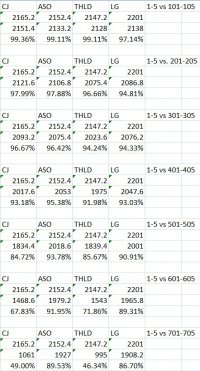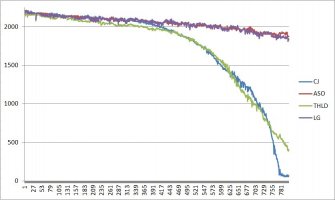Congratulations to Generic for the testing and sharing the results.
I know that this takes a lot of commitment to do manually.
I am only at 140 tests between 2 cells, and while each test is fairly quick, it still adds up.
That is a lovely offer.
It is nice to see someone else supporting generics testing and contributions to the community. I offered to provide an opus tester earlier on, so his device is not tied up.
I have had a quick look at your project and this looks very interesting to me as I also would like to do some repeated testing of cells.
I have started already with a single zb206 and tp4056 and have done 140 tests across 2 cells, so only 70 cycles for each cell.
I do have a bunch of questions that would be answered by being able to automate this testing. From the manual testing I have already done, I have determined that it would really not be feasible for me to do without automation.
I have many cells that are exactly the same type, and the packs have date codes.
I would like to observe how cells behave over many cycles where
-cells are different ages based on manufacture date
-cells that have had very little use
-cells that have had lots of use
-cells have been at zero volts and recovered
-1A charge and discharge
-0.5A charge and discharge
-reduced voltage range
I believe low use vs lots of use could be reasonably estimated based on the state of the packs and devices my cells come from.
I think the 1A vs 0.5A comparison would be a nice contribution to the second life storage community.
In theory the reduced currents and voltage range extend cell life, but being able to show the size of the effect in real life would be great.
I know that this takes a lot of commitment to do manually.
I am only at 140 tests between 2 cells, and while each test is fairly quick, it still adds up.
rev0 said:Wow, you did all these cycles manually? If you're interested in continuing this sort of testing I could send you an 18650 cycle tester I've been working on (would be an older version of which I have several), details are here: http://rev0.net/index.php?title=CCR It sure seems easier than manually restarting a cycle on these cells and taking down the data.
That is a lovely offer.
It is nice to see someone else supporting generics testing and contributions to the community. I offered to provide an opus tester earlier on, so his device is not tied up.
I have had a quick look at your project and this looks very interesting to me as I also would like to do some repeated testing of cells.
I have started already with a single zb206 and tp4056 and have done 140 tests across 2 cells, so only 70 cycles for each cell.
I do have a bunch of questions that would be answered by being able to automate this testing. From the manual testing I have already done, I have determined that it would really not be feasible for me to do without automation.
I have many cells that are exactly the same type, and the packs have date codes.
I would like to observe how cells behave over many cycles where
-cells are different ages based on manufacture date
-cells that have had very little use
-cells that have had lots of use
-cells have been at zero volts and recovered
-1A charge and discharge
-0.5A charge and discharge
-reduced voltage range
I believe low use vs lots of use could be reasonably estimated based on the state of the packs and devices my cells come from.
I think the 1A vs 0.5A comparison would be a nice contribution to the second life storage community.
In theory the reduced currents and voltage range extend cell life, but being able to show the size of the effect in real life would be great.









